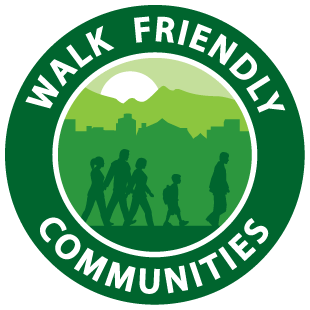Community Highlights
San Francisco is designated as a Platinum-level community due to the city’s outstanding planning practices, community pedestrian events, and focus on providing a pedestrian friendly environment. Highlights of San Francisco’s application include:
- San Francisco has a long history of supporting pedestrian-focused investments through policy action, including the 2011 Walk First program. The latest Vision Zero Action Strategy renews the City’s focus on walking and lays out aggressive steps to improve safety, address equity, combat climate change, and increase the share of trips taken by sustainable modes to 80 percent.
- San Francisco’s Better Streets Plan is a set of implementation strategies and goals to provide and maintain a better streetscape and pedestrian environment. The Plan “seeks to balance the needs of all street users, with a particular focus on the pedestrian environment and how streets can be used as public space.”
- Partnerships with other area agencies, advocacy groups like WalkSF, and broad-based coalitions have strengthened the City’s approach to Vision Zero and ensure community-driven responses to road safety problems.
- San Francisco is directing safety improvements based on some of the best injury data in the country, thanks to their partnership with the San Francisco Department of Public Health. The resulting TransBaseSF.org links transportation and public health data to inform the City’s comprehensive Vision Zero program.
- Evaluation is a central component of San Francisco’s programs, illustrated through the Safe Streets Evaluation Program. 40 projects from the City’s five-year capital improvement program are part of assessments that examine their impact based on a library of evaluation metrics.
- San Francisco has a model pedestrian signaling system. The guidelines for the installation of pedestrian signals state that all signalized intersections without pedestrian signals should be updated and all pedestrian countdown signals should be installed at new signalized intersections. San Francisco uses 3.0 feet per second as its maximum walking speed at signalized intersections, giving pedestrians of all ages and abilities the time they need to cross safely and comfortably. The City’s guidelines also state that Accessible Pedestrian signals should be provided with countdown signals to aid in the crossing of the visually and hearing impaired and intersections should be prioritized for new installations.
- San Francisco holds Sunday Streets events on the second Sunday of every month from April to October. The Sunday Streets event, based off the Colombian Ciclovia, creates a temporary public space by closing the road to motorists and creating a space for pedestrians and bicyclists to recreate, exercise, and socialize with fellow residents.
- San Francisco has worked to create a pedestrian friendly sidewalk network. The Department of Public Work’s Sidewalk Inspection and Repair Program evaluate sidewalks each year, make note of those in need of repairs, and work with property owners to make the repairs. Also, the City has a Newsrack Ordinance that was created to help reduce the amount of occupied space on sidewalks associated with free standing news racks and make sidewalks more pedestrian friendly. San Francisco also provides street landscaping to visually enhance the sidewalk to pedestrians.
- San Francisco’s streets and public rights-of-way make up fully 25 percent of the City’s land area, more space even than is found in all of the City’s parks. San Francisco’s “Pavement to Parks” looks to reclaim unused public spaces and turn them into temporary parks and public plazas. During the temporary closure of the space, the success of the plazas and parks is evaluated to what changes can be permanently made and what other solutions are possible. Residents and businesses can also apply for parking spaces in front of their properties to be turned into “Parklets,” which are mini parks the length of one or two parking spaces repurposed to be for pedestrians.
- The San Francisco Department of Public Health’s Program on Health, Equity, and Sustainability developed several Health Impact Assessment tools to provide insight on future pedestrian planning needs. The HIA tools are the Pedestrian Environmental Quality Index (PEQI), and the Vehicle-Pedestrian Injury Forecasting Model. Several specific HIAs in San Francisco include the Treasure Island Community Transportation Plan, an HIA of Traffic in Southeastern San Francisco, and an HIA of Road Pricing.

